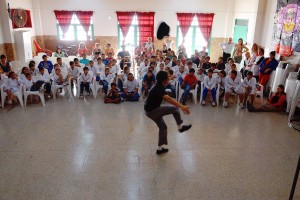Argentina’s alternative learning spaces
I read Pavel’s entry, and I was thinking about how extracurricular learning environments work here. Clubs obviously exist, but access to them is limited by how much money families have. Pavel suggests in his entry that people tend to look for alternatives outside of the educational model because it hasn’t kept up with the world’s development. For poverty stricken communities in my country, it’s the opposite: kids are falling out of the educational system because they can’t even keep up with its basic demands. That’s due to the fact that their needs are unmet.
Many things are being done against this trend. As far as institutions go, all public schools and some private catholic schools provide meals for the kids. For most of them, it is the only place where they can get something to eat. So schools become not just spaces to learn but also dining halls.
Then there are also political associations that work to address these needs. Usually a group of people go inside slums and spend a whole morning giving school aid to kids, or organizing different artistic workshops, like dance classes, etc.
Finally, NGOs are also trying to give new hope to young people from impoverished areas. At the NGO where I work, there is a program called the Moving Circus. The project offers circus classes to kids in poor neighborhoods, and it travels from town to town.
During the opening meeting for the circus comeback in Barrio Mosconi, a poverty-stricken neighborhood in the district of Ensenada, a lot of interesting things came up. We had managed to arrange a meeting with the head of a primary school, the head of a secondary school, the coordinator of a co-op called ‘Futuro Ensenadense,’ and the director of a sports club in Mosconi along with some primary school teachers. They agreed their main challenge is figuring out what to do with kids after school hours. Since the mornings are taken care of, many projects focus on finding extracurricular activities for students in the afternoon. Children and teenagers in this neighborhood don’t usually have a proper home to go back to after their school day is over. Their parents are either working or not looking after them, so they spend most of their free time in the street.
Luis, the head of the sport club, told us how he tried to keep kids off drugs through sports. He managed to put together a football team, and a lot of the boys in the neighborhood joined. Liliana, the head of primary school, told us how they managed to bring together some volunteers who formed a readers’ group for first and second graders.
“But we couldn’t have that for long,” she said, “Because the young women in charge were very willing and enthusiastic, but they were not trained tutors.”
Truth is, skilled people’s qualities are a must when dealing with kids that come from poverty-stricken homes – and usually little ones don’t find the emotional support they need.
The moving circus in this sense was part of a solution for giving kids something to look forward to in the afternoons. But was it really? I wondered: the dire situation is so overwhelming sometimes: Is this just a drop in the ocean?
But it turns out it did make some impact in this community. Liliana told us that they had put up a small circus for the end of the year concert, and the kids had a chance to show teachers and parents their new skills. This was a total surprise to the rest of the team and me – real proof that something had changed here.





